Cincinnati, Ohio is smaller than Pittsburgh and bigger than Plano, Texas. It has no national landmarks, and its topography is lovely without being majestic. It will never host an Olympics, but still hosts lesser known international events like 2012’s World Choir Games. Cincinnati is neither teeming nor quaint, both too big and too small for family vacations or honeymoons. It has an international airport and two major league sports teams, all well-equipped yet unreliable. It makes fast paced tourism videos touting, “old world charm and cosmopolitan style”, knowing it has river boats and historical architecture, if only someone would notice them. But for a brief moment in the early 1990s, it seemed ready to become a place where people came to stage the country’s dreams.
Shot and partially set in Cincinnati, Rain Man was released in 1988 to worldwide critical and popular acclaim. Tango and Cash was filmed in the city the year afterwards, followed by Little Man Tate, starring Jodie Foster and featuring prominent use of Cincinnati locations. 1990 saw A Rage in Harlem and John Sayle’s City of Hope substitute the Cincinnati area for New York City locations. Cincinnati’s picturesque hills, early 20th century architecture and river proximity made it a frequent stand in for various boroughs. In 1991, the city doubled for 1920s Yonkers when Martha Coolidge filmed her adaptation of Neil Simon’s Lost in Yonkers.
From 1987 to 1991, twelve productions brought an estimated $30 million into Cincinnati’s economy. According to the New York Times’ Roberta Hershenson, late 1992 was a time when the city was looking forward with increasing optimism for its cinematic future. With the creation of the Greater Cincinnati Film Commission, representing sections of Northern Kentucky and Eastern Indiana, sights were set on constructing full time production facilities, as well as persuading studios to further capitalize on the area’s locational resources. But even as the city pushed for its ability to serve as a reliable stand-in, the impulse to go further must have run deep. Aside from Little Man Tate, none of the films shot there had featured Cincinnati as their primary location. But, as the sentiment went at the time, it was the 90s, a dawning era of Clinton optimism. What the city needed was a geocinematic calling card, a populist crowd pleaser based heavily in place like Rocky, or an equally city-centric art house hit, what Drug Store Cowboy was for Portland, Oregon. What they got was Beach Blanket Bingo.
In the summer of 1992, inline skating was in search of a national identity, a legitimacy as both a lifestyle and a sport. What this burgeoning subculture needed was cachet. It needed to be cool, to break away from the sequined uniforms of competitive roller disco, to distinguish itself from the world of Roller Derby. Skateboarding had been building this kind of clout since the 1960s, developing culturally and stylistically into, what, by 1992, was an established system of businesses and cultural touchstones. And though major inline skating brands like Rollerblade had begun to penetrate into the markets of major sporting goods retailers by the late 1980s, the sport lacked both mainstream appeal and the outsider reputation afforded to skateboarding. What the inline skating community needed was a unifying event, a competition or performance bolstered by a national platform. But the first X Games was still three years away. So they settled for a movie.
There had been films based around extreme sports before. 1986 trash classic Thrashin had been made with the cooperation of future skating stars like Tony Hawk and Steve Caballero, but left little impact outside of an early starring role for Josh Brolin. The failure of such films to launch a subsequent mini genre of extreme sports films may have been a lesson that Warner Brother’s Pictures could have considered before moving forward with production on their own project. But it was a time when the big dreams of two fledgling institutions aligned for just long enough to foster momentary collective delusion. Cincinnati needed films and inline skating needed exposure, while it’s rising stars needed to find ways to translate their sport into employment. The end result would simultaneously move inline skating closer to cultural cohesion, and move Cincinnati closer to cinematic obsolescence.
To watch Airborne now, with its painfully dated soundtrack and embarrassing haircuts, requires a strong dose of ironic distance, but not as much as you might think. It’s a film that clearly wants very much to be liked, to prove that not only is skating cool, but that it can be relied upon to resolve all the usual teen move conflicts. To paraphrase Roger Ebert’s review of Teenage Mutant Ninja Turtles, Airborne is nowhere near as bad as it might have been, and probably is the best possible inline skating teen movie. More than that, however, Airborne has a wildly uneven relationship with its own authenticity. It exerts huge amounts of energy staging embarrassing montages (including a “trying on clothes” scene set to Right Said Fred’s ubiquitous “I’m Too Sexy”) only to accidentally capture the essence of local youth culture in the faces of background extras.
The plot is a meta narrative for the value of middle sized urban areas. It opens with Mitchell Goosen (Shane McDermott) skating and surfing in the orange glow of an idyllic California beach town. When he is informed that his parents are shipping him off to spend the next six months in Cincinnati, the news is delivered with all of the finality of a death sentence. Our first glimpse of the Midwest is actually the snow shrouded tarmac of the international airport in Kentucky. Goosen steps into the white void like the condemned prisoner of some Siberian gulag, a coastal god cast into Midwestern purgatory. But through the affection of a young woman, confrontation with his own inner demons and the achievement of respect by his peers, Goosen ultimately accepts his new role as a reluctant inlander. That this is achieved through constant interaction with the urban environment via skates is the film’s propagandist soul.
Cincinnati and Northern Kentucky are not just represented here, they are omnipresent, as is their role as extended skate parks. Airborne is a Cincinnati tourism video with a few actors propped up in front of it to lend it some legitimacy. When Goosen and his love interest kiss on their first date, they do so on the polished docks of the waterfront of Kentucky’s’ Newport on the Levee, the Cincinnati skyline framed perfectly in the background. To the right is the John A. Roebling Suspension Bridge, a scaled down prototype that served as the model for the Brooklyn Bridge. The bridge would have been familiar to viewers in 1992 as a location from Rain Man, but here it is a romantic backdrop, as if urging us to concede its commonality with the backdrop of Woody Allen’s Manhattan.
Even the film’s interiors make use of Cincinnati locations, with the classroom scenes shot in Western Hill’s High School. Goosen first woos his girlfriend in the local A.J. Rahn Greenhouse, where he simultaneously expresses the joy of young love by skating through the plant shrouded aisles to the accompaniment of a topically perfect early 90’s slow jam.
When the chance encounter leads to a second date, Goosen expresses his joy by exclaiming, “I think I’m starting to like Cincinnati,” and then partaking in an orgasmic skating montage through its streets. The force of the joy wrought by his skating session is so great, it inspires spontaneous accompaniment by random BMX bikers and a trio of skate boarders. The whole thing culminates in a totally unplanned half pipe session with a full crowd. This is a musical where the characters break out into skating. It’s a scene length advertisement for the way street sports can enhance your relationship with urban space. All of this, however, is just a prelude to the film’s final twenty minutes.
There is no such thing as Devil’s Backbone. Though Cincinnati has plenty of hills, there is no magical peak that swerves back and forth across both sides of the river before terminating at what was once the base of the now demolished Riverfront Stadium. But this is the setting for Airborne’s climactic race, a sequence that serves both as a tour of the area in 1992, and a bold faced lie about that area’s geography. On purely cinematic terms, the sequence is better than it has any right to be. The film was directed by Rob Bowman, who would go on to helm big budget action films like Reign of Fire and become a leading force behind the television series Castle. Here, he employs a control of onscreen space that manages to ground the sequence’s inherently preposterous setup.
Looked back on from an era where so many action scenes have sacrificed spatial coherence for kinetic energy, the race feels almost classical in its slow build, tracking the progression of nearly a dozen different characters as they maneuver downhill towards an unseen finish line. The scene progresses without dialog, building tension out of the pure physicality of its racer’s mode of transportation. Closeups of ankle braces shedding blue sparks against concrete highlight the potential for sudden impact, while the interaction between racers and urban obstacles vacillates from reckless grace to a clumsy desperation for speed. And while the extent of the race’s near endless downhill trajectory is patently ridiculous, little occurs outside of what would be physically possible for a skilled skater.
Much of this comes from the stuntwork of numerous inline skating professionals who would go on to become the backbone of their sport’s future. Lead actor Shane McDermott’s stunt double was Chris Edwards, who also portrayed another one of the film’s characters. Edwards was an early inline skating innovator who would turn professional in 1995. Further stunts were provided by Chris Mitchell, whose involvement in the early X Games helped develop the rules for competitive skating, while both men were early members of Team Rollerblade, whose involvement in the film helped achieve its many skating sequences. Airborne was a flashpoint for the inline skating talent of the early 90s. Behind the scenes roles were also filled by members of the extreme sports community. Second unit director Steve Boyum had been a surfer and stuntman, as well as a ski and motocross racer, before his involvement on the film. Skating supervisor Pat Parnell went on to a work as an announcer and host for various high profile sporting events.
For many members of the production team not involved with the sports community, Airborne was an early entry in what would become successful careers. Producers Stephen McEveety and Bruce Davey went on to a long, Oscar winning stint as the team behind all of Mel Gibson’ directorial efforts, including Braveheart and The Passion of the Christ. Production designer John Myhre won Oscars for his work on Memoirs of a Geisha and Chicago, with his most recent credit being X-Men: Days of Future Past.
From the costume designer to the set decorator, Airborne was a confluence of career professionals, the future vanguard of Hollywood producing talent. They were all there for that briefest of moments in the dawning of the new decade. It must have felt like something wonderful was about to happen. And for many of those involved, this was true. Including pre fame Jack Black and Seth Green, Airborne would serve as a stepping stone to future success for nearly everyone involved, with the exception of the city and actor around which it was centered. All this professional involvement creates an impressive final sequence that ultimately exhausts the possibilities for onscreen skate races. The race caps off not just the film, but the very potential for inline skating films to evolve into a genre.
Released in the United States in September of 1993, Airborne barely recouped its own $2.6 million budget with a $2.8 million take. Maybe in some alternate 1994 universe, Shane McDermott became the Franky Avalon of the inline skating movie craze, instead of a realtor in Galveston, Texas. That this never happened is a testament to the fact that people just aren’t that interested in watching people skate on film. The audience that may have existed for Airborne in 1993 was more likely to spend their time actually skating than watching people do it onscreen. Herein lies the key difference between the surf movie of the sixties and the near nonexistent skating movie of the 90s. Baby boomer teens without easy access to the oceans of the west coast were at least willing to settle for their cinematic substitute. Gen X teens who wanted the thrill of extreme sports could just find a hill or a set of stairs and do it themselves. And unlike the inherently cinematic thrill of watching an onscreen car chase, there is something anticlimactic about even the most exciting moments of a skating race scene. People don’t really crash. They just kind of fall down.
Airborne wasn’t the only film shot in Cincinnati released in 1993 (sharing that small honor with the forgotten Melanie Griffith vehicle Milk Money). The following decade would see productions both large and small come to the city, including Steven Soderbergh’s Traffic in 2000 and Seabiscuit in 2003. But none of these productions featured Cincinnati as a major setting. The Greater Cincinnati Film Commission survives to this day, and seems to have fulfilled their goal of constructing various production studios in the area. But the only film their website reports having shot there in 2013 was the Hallmark Channel’s The Christmas Spirit. The year before that, the only film shot in the area was the low budget horror film Seven Below. Perhaps alarmed by the near nonexistence of local film shoots, Ohio Governor John Kasich signed legislation in 2012 that doubled the tax incentives for film productions from $10 million to $20 million. And perhaps the move is working. On January 1st of 2014, production offices opened for Carol, set to star Cate Blanchett and Rooney Mara. Par for the course, the film is a period piece set in New York City.
The promise that may have been imaginable to the burgeoning film commission in those closing years of the 1980s seems hard to summon now. Twenty plus years later, it’s still possible to feel the sting of failure that Airborne must have left behind. In addition to being a calling card for casual viewers, a kind of debutante coming out ball for Cincinnati’s backdrops, Airborne all but screams for the city’s viability as a production capital. Look how easy it is to shoot here, it pleads. If we can stage an overly elaborate skating race in our streets, just imagine what we could do for your production. It would be unfair to place Cincinnati’s eventual atrophying of productions on the financial failure of a low budget movie like Airborne. It seems equally unfair to label the film’s failure as an indictment of the broad appeal of extreme sports in the early 1990s. Inline skating simply had yet to find itself, and film was not the avenue by which it would do so. Airborne‘s very existence seems possible only in the relative cultural vacuum that existed before the creation of the X Games. What makes the film fascinating is its constant vacillation between a sanitized depiction of what Hollywood thought skate culture looked like, and the accidental documenting of the faces and poses of young men in Kentucky in the 1990s.
Cincinnati is not a place people go to fulfill dreams of personal mythology. It sits in the part of the country that coastal people refer to as the flyover. For most, it will never be more than a smattering of lights glimpsed from 50,000 feet in between Los Angeles and Boston. Its a place built on the pragmatic dreams of nineteenth century pork magnates. But it was once the west, the esteemed cultural border of the country until expansion left it dangling in geographic limbo. And in its plot about a cool west coast surfer coming to adopt Midwestern blandness, Airborne is a perfect encapsulation of the search for identity and economic vitality that faces not just Cincinnati, but many midsize cities. Ohio may have no coasts, the film says, but there is water there. It speaks not just for Cincinnati, but any city that grasps unsuccessfully at economic and cultural relevance, only to end up with a hokey movie about skating.
Krishna Bala Shenoi is an artist from Bangalore, India. You can see a lot of his work and find out more here.

















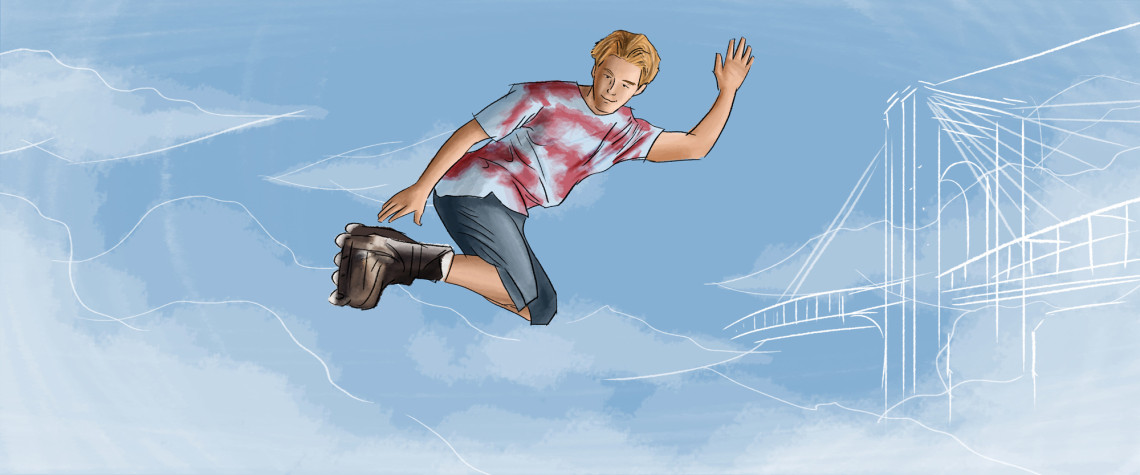
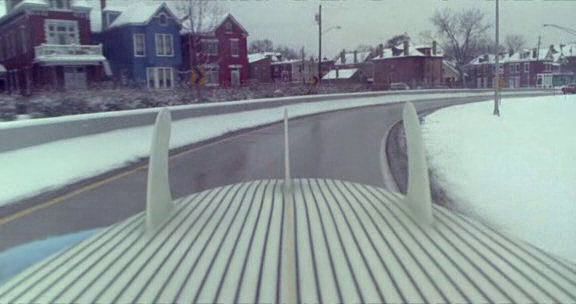
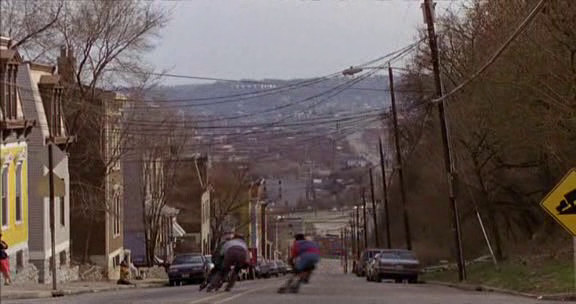
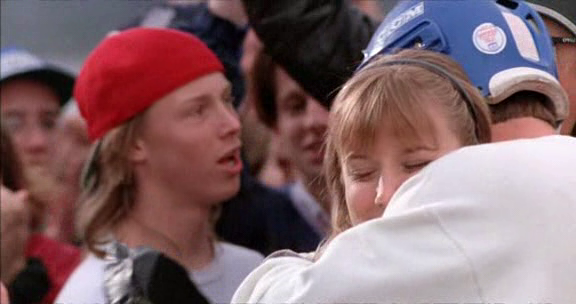
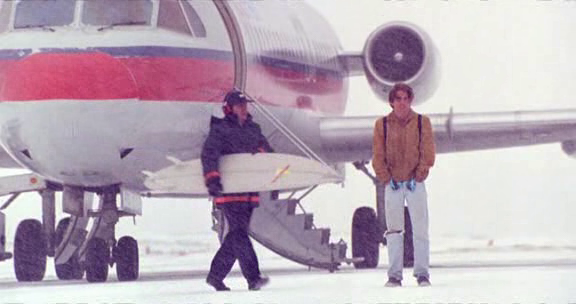

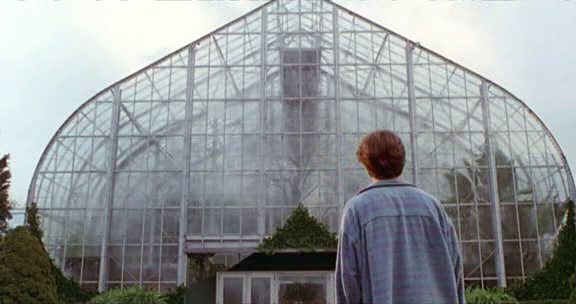
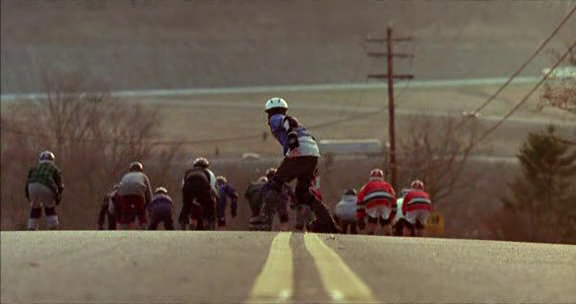

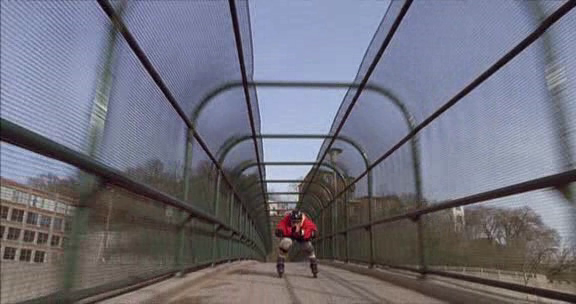
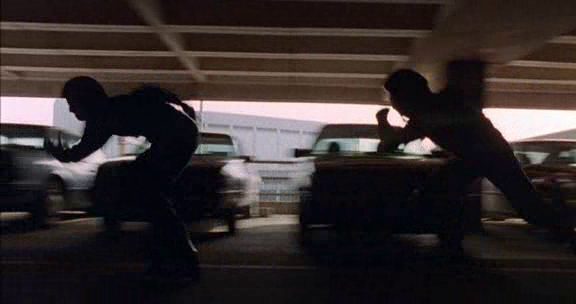
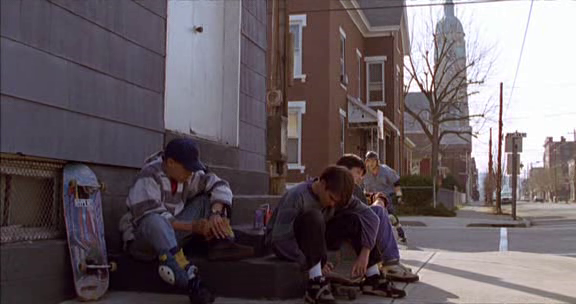
5 thoughts on “The Dream of 92: Cincinnati, “Airborne,” and the Cinematic Capital that Never Was”
I can say this way certitude: That’s the most in depth look at an inline skating movie shot in Cincinnati, Ohio I have ever read.
I’m from the Cincy area — really enjoyed the piece.
Devils Backbone is a road on Cincinnati’s suburban west side.
Robling Bridge goes into Covington, not Newport. They’re kissing in Covington. Also there was no Newport on the Levee until the early 2000s.
That is not AJ Rahn’s Greenhouse. It is Krohn Conservatory.
Also, you might want to update this article with a list of movies that have been filmed in Cincinnati since 2014. You will find your commentary sorely mistaken.